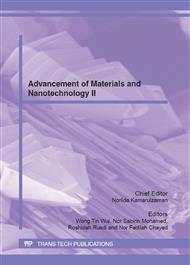p.100
p.105
p.111
p.119
p.124
p.129
p.137
p.143
p.148
Investigation of Wear Properties of Al-4.5wt.%Cu Nano-Composite Reinforced with Different Weight Percent of TiC Nano Particles Produced by Mechanical Alloying
Abstract:
Resistance to wear is an important factor in design and selection of structural components in relative motion against a mating surface. The present work deals with studies on the wear behavior of metal matrix composites manufactured using powder metallurgy technique of ball milled mixing in a high energy attritor and using a blend-press-sinter methodology. Matrix of pre–mechanical alloyed Al-4.5 %wt Cu was used to which different weight percents of nano-sized TiC reinforcement were added. Microstructural characterization of the materials revealed reasonably uniform distribution of TiC reinforcement and presence of minimal porosity. Wear tests were performed using a pin on disk apparatus. The MMCs were rubbed against a carbon steel pin under loads of 10 and 20 N at a sliding velocity of 0.1 ms−1; the environmental humidity lower than 30% and a track length of 1500 m. The degree of improvement in dry sliding wear resistance and hardness brought about by reinforcement is strongly dependent on the weight percent of reinforcement and the wear behavior was determined through the precise measurement of weight loss of the samples. Worn surfaces were analyzed by scanning electron microscopy (SEM) and energy dispersive spectroscopy (EDS).
Info:
Periodical:
Pages:
124-128
Citation:
Online since:
July 2012
Price:
Сopyright:
© 2012 Trans Tech Publications Ltd. All Rights Reserved
Share:
Citation:


